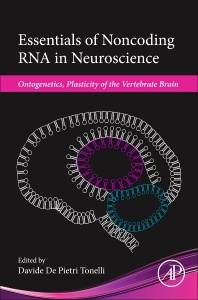Essentials of Noncoding RNA in Neuroscience Ontogenetics, Plasticity of the Vertebrate Brain
Coordonnateur : De Pietri Tonelli Davide

Essentials of Noncoding RNA in Neuroscience: Ontogenetics, Plasticity of the Vertebrate Brain focuses on the role of miRNAs in neurogenesis, gliogenesis, neuronal network formation, and the cell biology of forebrain development. The important role miRNAs play in neuronal maturation, neocortex function, and in some neurodevelopmental disorders is discussed, as are the computational challenges and methods used in the identification of miRNA targets.
This book is a valuable reference for neuroscientists who wish to better understand the role of miRNAs in complex processes. It is of strong interest to those working to develop enabling technologies to detect and monitor miRNA expression and function, and to evaluate its roles in neural progenitor proliferation/differentiation, neuronal plasticity, and learning and memory.
Intro to miRNAs and methods 1. Making and Maintaining MicroRNAs in Animals 2. Essentials of miRNA-dependent control of mRNA translation and decay, miRNA targeting principles and methods for target identification 3. Computational challenges and -omics approaches for the identification of miRNAs and targets 4. Methodological challenges in functional investigation and therapeutic use of microRNAs
Neurogenesis 5. The cell biology of neural stem and progenitor cells and neocortex expansion in development and evolution 6. miRNA-dependent and independent functions of the Microprocessor in the regulation of neural stem cell biology 7. Epigenetic Regulation of Neurogenesis by MicroRNAs 8. MiRNAs in mammalian adult olfactory neurogenesis 9. microRNA-mediated regulation of adult hippocampal neurogenesis and implications for hippocampus-dependent cognition and related disorders
Gliogenesis 10. Transcriptional and Epigenetic Control of Astrogliogenesis 11. microRNAs in Oligodendrocyte Myelination and Repair in the Central Nervous System
Plasticity and brain dysfunctions 12. MiRNA in neuronal networks maturation and plasticity 13. Small RNA dysregulation in neurocognitive and neuropsychiatric disorders
Emerging complexity in small RNA classes and functions 14. Circular RNAs expression, function and regulation in neural systems 15. Comparative functions of miRNAs in embryonic neurogenesis/neuronal network formation 16. MicroRNA and neocortical evolution
- Discusses the unique features of neural miRNAs
- Details functional investigation of miRNA actions and current experimental approaches
- Includes extensive coverage of miRNA biology, developmental and postnatal neurogenesis, and computational challenges for miRNA target identification
- Contains thorough discussion of the transcriptional control of miRNA expression in forebrain development and in specific neuronal subtypes, as well as miRNA function in neurogenesis, neuronal network maturation, plasticity, gliogenesis, and dysfunction
- Provides an overview of miRNA roles in neurodevelopmental disorders and their possible role in the evolution of the neocortex
Date de parution : 06-2017
Ouvrage de 338 p.
19x23.3 cm
Thèmes d’Essentials of Noncoding RNA in Neuroscience :
Mots-clés :
ASD; Adult olfactory neurogenesis; Argonaute; BAF complex; Basal progenitor heterogeneity and proliferation; Bipolar disorder; Bmpr-I; Bmpr-II; Brain; Brain cancers; CLIP; CNS evolution; Cell division; Chimera; CircRNA; Competing endogenous RNA; Conserved microRNAs and neurogenesis; Cortical expansion in evolution; Cortical neurogenesis; Cytokines; DNA; Demyelinating diseases; Dicer; Drosha; EIciRNAs; EMT; Epigenetics; Expression profiling; Fate specification; Functional investigation target val



